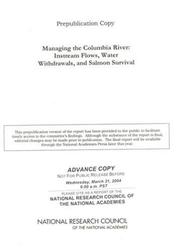| Listing 1 - 2 of 2 |
Sort by
|

ISBN: 0309091551 9786612084027 128208402X 0309530377 9780309530378 9780309091558 0309166268 Year: 2004 Publisher: Washington, D.C. : National Academies Press,
Abstract | Keywords | Export | Availability | Bookmark
 Loading...
Loading...Choose an application
- Reference Manager
- EndNote
- RefWorks (Direct export to RefWorks)
Electronic books. -- local. --- Fishes -- Conservation -- Columbia River. --- Pacific salmon -- Columbia River. --- Water resources development -- Columbia River Watershed. --- Water withdrawals -- Columbia River Watershed. --- Water resources development --- Water withdrawals --- Pacific salmon --- Fishes --- Conservation --- Fish --- Pisces --- Drafts, Water --- Water drafts --- Withdrawals, Water --- Aquatic animals --- Vertebrates --- Fisheries --- Fishing --- Ichthyology --- Oncorhynchus --- Salmon --- Water-supply --- Energy development --- Natural resources --- Columbia River Watershed --- Environmental conditions. --- Columbia Basin --- Columbia River Basin
Book
ISBN: 1771601795 9781771601795 Year: 2016 Publisher: Victoria, BC
Abstract | Keywords | Export | Availability | Bookmark
 Loading...
Loading...Choose an application
- Reference Manager
- EndNote
- RefWorks (Direct export to RefWorks)
"A River Captured explores the controversial history of the Columbia River Treaty and its impact on the ecosystems, indigenous peoples, contemporary culture, provincial politics and recent history of southeastern British Columbia and the Pacific Northwest. Long lauded as a model of international cooperation, the Columbia River Treaty governs the storage and management of the waters of the upper Columbia River basin, a region rich in water resources, with a natural geography well suited to hydroelectric megaprojects. The Treaty also caused the displacement of over 2,000 residents of over a dozen communities, flooded and destroyed archaeological sites and up-ended once healthy fisheries. The book begins with a review of key historical events that preceded the Treaty, including the Depression-era construction of Grand Coulee Dam in central Washington, a project that resulted in the extirpation of prolific runs of chinook, coho and sockeye into B.C. Prompted by concerns over the 1948 flood, American and Canadian political leaders began to focus their policy energy on governing the flow of the snow-charged Columbia to suit agricultural and industrial interests. Referring to national and provincial politics, First Nations history, and ecology, the narrative weaves from the present day to the past and back again in an engaging and unflinching examination of how and why Canada decided to sell water storage rights to American interests. The resulting Treaty flooded three major river valleys with four dams, all constructed in a single decade. At the heart of this survey of the Treaty and its impacts is the lack of consultation with local people. Those outside the region in urban areas or government benefited most. Those living in the region suffered the most losses. Specific stories of affected individuals are laced with accounts of betrayal, broken promises and unfair treatment, all of which serve as a reminder of the significant impact that policy, international agreements and corporate resource extraction can have on the individual's ability to live a grounded life, in a particular place. Another little-known aspect of the Treaty's history is the 1956 "extinction" of the Arrow Lakes Indians, or Sinixt, whose transboundary traditional territory once stretched from Washington State to the mountains above Revelstoke, B.C. Several thousand Sinixt today living south of the border have no rights or status in Canada, despite their inherent aboriginal rights to land that was given over by the Treaty to hydroelectric production and agricultural flood control"--Publisher's website.
Water resources development --- Energy development --- Natural resources --- Water-supply --- Law and legislation --- Social aspects --- Environmental aspects --- Columbia River Watershed --- Columbia Basin --- Columbia River Basin --- Social conditions. --- Columbia River Treaty --- Treaty between Canada and the United States of America relating to Cooperative Development of the Water Resources of the Columbia River Basin --- Treaty between the United States of America and Canada relating to Cooperative Development of the Water Resources of the Columbia River Basin --- Columbia Treaty
| Listing 1 - 2 of 2 |
Sort by
|

 Search
Search Feedback
Feedback About UniCat
About UniCat  Help
Help News
News